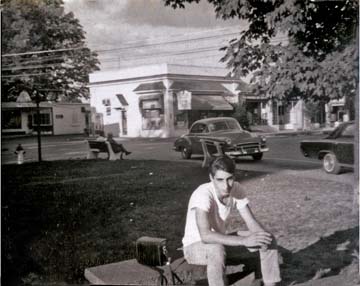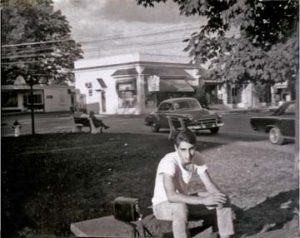In the 1960s, Bob Dylan, Peter Paul and Mary, The Band, and later Janis Joplin and Jimi Hendrix were active in the Woodstock area. So, what was it like to grow up in Woodstock in the 1960s? Recently I chatted with Frank Spinelli, the photographer and writer, to explore his life and early times.
Frank’s family moved to Woodstock during the summer of 1963. While attending Onteora High School, he used to ride the school bus into town. A favorite hangout was the News Shop across from the Village Green. Frank was friendly with the proprietor’s son, Fred, and used to snack on after-school burgers and milkshakes.
Spinelli’s main coming-of-age passions were chasing girls and having a good time. Other hangouts besides the News Shop included the Village Green and the Woodstock Youth Center. In 1965 he was the WYC’s first president.
The countercultural movement was a parallel scene, and it didn’t really impact him, but this began to change in 1966 when Frank had to enroll for the selective service and became eligible for the draft. Consequently, he began to pay more attention to the issues of the day. He remembers one time that a lefty told him that he “should not be cannon fodder” and that he “should go to Canada.”
The summer of 1970 was a watershed moment for Frank. The Woodstock Festival took place the previous year, and all kinds of people moved to town. It was also the time that the psychedelic movement hit Woodstock. Kids older than Frank used to hop in a car with a shotgun and head into the woods to shoot bottles and cans. His generation got their recreational high from pot. Spinelli didn’t really relate to the music or the musicians of the day. For the most part, they were ordinary folks that he would see around town. One place he saw a good bit of local musicians was as a bartender at the Sled Hill Café.
Some years ago, in a letter to the editor of the Woodstock Times, he had this to say about the Sled Hill Café:
“It was a cobbled-together construction of dump castoffs, bargain lumber, and garage sale secondhand. Its retro fifties design looked before its recent demise as much as it did back then. The floor was an uneven slab of concrete supporting the only splash of elegance in the large open room, three ancient leather banquettes sitting like old ladies along the east wall. On the opposite side of the room were faded polyethylene ceiling panels that diffused the interior light to a daunting hepatitis yellow. The kitchen was behind the bar, and the cook actually kept a notched count of murdered rats. The bathrooms never worked, and although the jukebox was lively, the strangest songs came during the August thunderstorms, which spawned the streams that flowed from Tinkers Street through Mower’s market parking lot (now Oriole 9), gained momentum and detritus as they plowed down Deanie’s Alley, crossed Deming Street, and then hurried down Sled Hill to find its natural resting place, the concrete floor of the Café itself. The arrival of the tidal wave was generally unannounced due to the music and the crowd, but its presence was known by the universal sigh let out by the revelers when they realized they were up to their shins in water.”
As one of four bartenders in 1970 at the Sled Hill Café, Frank met his share of musicians: Billy Batson, Tim Hardin, Van Morrison, Leslie West, and Paul Butterfield. He recalls that around 2:45 a.m., members of The Band—Levon, Rick, and Richard—used to amble in and order ten or twelve Go Fasters (two shots of brandy and a spritz of ginger ale). As these were lined up on the bar, the boys worked their way through them. Then, amply fortified, they turned their attention to the stage and performing. It was at this moment, according to Spinelli, that they became larger than life—and that he connected with them as artists. The rustic rough-hewn quality of the place would be magically transformed by the glorious music. The potent mix made for a giddy high, and Frank recalls that he loved it.
~ Weston Blelock



Corrections:
Go Faster was 2 shots of vodka, one shot cherry brandy, lemon wedge, filled with either club soda or seven up.
Psychedelics came to Woodstock in the early 60’s, mostly in the form of peyote, morning glory seeds and belladonna (DO NOT EVER TAKE BELLADONNA!).
Despite its physical reality, the Sled Hill Cafe had the best music scene on the EAST COAST during the two years it thrived before being closed by the federal government in October, 1971.
The Sled hill must have re opened cause I washed dishes there in in 1972-73 / and it was down the hill and around the corner from the joyous lake. I Gave Maria Muldore a kiss on the cheek there one night. And your right the bathrooms never worked! Buzzy featon , the guy from Mountain many great artists went there!